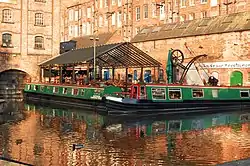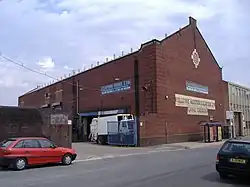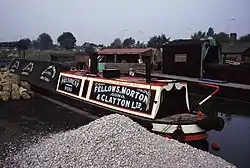Fellows Morton & Clayton
Fellows Morton & Clayton Ltd was, for much of the early 20th century, the largest and best-known canal transportation company in England.[1] The company was in existence from 1889 to 1947.

Origins

The company started in 1837 when James Fellows, an agent for a canal carrier, decided to start his own company.[2] James was 32 and based in West Bromwich. His first boat was called "Providence". In January 1839 he was allowed toll credit on the Warwick and Napton Canal as his boats were working down to London so frequently. He expanded rapidly and moved his operation to Toll End in Tipton in 1841. His business was as a "Railway & Canal Carrier" even though his rail activities were minor. James died in 1854 aged 49, and his widow Eliza carried on the business until their son Joshua was old enough to be an official partner. By 1855 he was transporting 13,000 tons of iron castings between London and Birmingham each year.[3]
In the late 1850s a new boat-building facility was built at Tipton and by the early 1860s the fleet had grown to some 50 boats. Long-distance carrying was the mainstay of the business during these early years.
In 1876 Frederick Morton brought with him investment capital to expand the business, and the company name was changed to Fellows Morton & Co. This new company continued to absorb smaller traders, so expanding with new boats and also with acquired vessels.
Formation of the company
In 1888–1889 William Clayton of Saltley, who operated a special fleet of liquid cargo boats as well as traditional loads, became the third partner. William died before the companies merged formally but his son, Thomas, took his place. Fellows, Morton & Clayton Ltd. was formed on 3 July 1889.
The three managing directors appointed at the first meeting of the new company were Joshua Fellows, Frederick Morton and Thomas Clayton, on salaries of £600 (equivalent to £70,000 in 2021),[4] each. The new chairman of Fellows, Morton & Clayton Ltd. was Alderman Reuben Farley the majority of shareholders being family members of the directors of the company.
At the time of formation the general cargo fleet amounted to some 11 steamers and around 112 butty boats. The tank boats were transferred to another new company which was called Thomas Clayton Limited of Oldbury.[5]

The company's first results for the 18 months ending 30 June 1890 showed a net profit of £7,497 (equivalent to £880,000 in 2021).[4] Trading had not been easy to start with – a dock strike in London had caused a serious financial loss and an epidemic of Russian influenza amongst the horses had caused many deaths. However, as there was new traffic, a new basin and headquarters were completed at Fazeley Street in Birmingham. The headquarters were designed by the builder Edwin Shipway.[6] The company had also acquired the interests of a rival carrier, Fanshaw and Pinson. The capital then stood at £84,620 (equivalent to £9,910,000 in 2021);[4] barges, boats and steamers were valued at £20,852 (equivalent to £2,440,000 in 2021),[4] and horses at £4,000 (equivalent to £470,000 in 2021).[4]
Last known working boats in existence
Currently there are only 29 of these boats still in existence, 6 of which are still in use to this day. The last remaining boats of this type are in the National Waterways Museum. There are 12 recorded sink-ages, and there are two currently in restoration. The conditions of the rest are currently unknown. Any information to improving this section is welcome.
Steam-powered boats

In the new boatyard at Fazeley Street they built five steel-plate steam-powered boats. After an initial period of use they were found unsatisfactory because of the excessive wear on the hull's steel.[8]
In 1896 Fellows Morton & Clayton tried iron in the construction of their boats. The boat had an elm bottom and iron sides.[9] This proved much more effective and 3 of the 5 original steel steamers were rebuilt.
Between 1898 and 1899, 8 more iron composite steamers were produced from the Saltley dock and 9 more between 1905 and 1911.
The steamers were known as fly-boats or express-boats and kept mainly on main-line long-distance routes. On the timetable, a trip from London (City Road Basin) to Birmingham (Fazeley Street Depot) would take around 54 hours. It was a non-stop service and the crew of four would change shifts along the route. The main drawback was the lack of carrying space on the boat due to the size of the engine and boiler. The boats picked up coke at preset points along their routes.
President survives and is owned and operated by and from the Black Country Living Museum.
List of steamers built by Fellows Morton & Clayton
| Name | Construction type | Construction location | Construction date | Registration | Registration date | Engine | Boiler | Fate |
|---|---|---|---|---|---|---|---|---|
| Hecla | Wooden | Toll End, Tipton | 1886 | Birmingham 803 | 27 Mar 1892 | W. H. and A. H. Haines Ltd. Birmingham | Cochranes, Birkenhead | Dismantled November 1921 |
| Queen | Wooden | Toll End, Tipton | 1887 | Wolverhampton 591 | W. H. and A. H. Haines Ltd. Birmingham | Cochranes, Birkenhead | Dismantled around 1910 | |
| Duchess | Wooden | Toll End, Tipton | 1887 | Birmingham 841 | 16 Feb 1893 | Unknown | Unknown | Sold May 1893 |
| Victoria | Wooden | Toll End, Tipton | 1887 | Birmingham 884 | 27 Oct 1893 | Nettlefolds, Birmingham | J. Watt and Co, Birmingham | Dismantled July 1919 |
| Phoenix | Wooden | Saltley by FMC | Dec 1893 | Birmingham 886 | 1 Dec 1893 | FMC | Danks, Oldbury | Dismantled Sep 1925 |
| Speedwell | Wooden | Saltley by FMC | Mar 1894 | Birmingham 892 | 20 Apr 1894 | Nettlefolds, Birmingham | Cockranes, Birkenhead | Dismantled Sep 1925 |
| Pirate | Wooden | Saltley by FMC | Jun 1894 | Birmingham 900 | 16 Jun 1894 | Nettlefolds, Birmingham | Fletchers, Derby | Sold Dec 1902 |
| Duke | Wooden | Saltley by FMC | Mar 1895 | Birmingham 930 | 29 Mar 1895 | FMC | Cockranes, Birkenhead | Dismantled Jun 1923 |
| Earl | Wooden | Saltley by FMC | Jun 1895 | Birmingham 939 | 28 Jun 1895 | FMC | Cockranes, Birkenhead | Sold Nov 1925 |
| Princess | Iron Composite | Saltley by FMC | Jun 1896 | Birmingham 959 | 12 Oct 1896 | FMC | Cockranes, Birkenhead | Converted to motor boat Pilot Dec 1924 |
| Countess | Iron Composite | Saltley by FMC | Jun 1897 | Birmingham 987 | 1 Oct 1897 | FMC | Burrells, Thetford | Converted to motor boat Captain July 1924 |
| Marquis | Iron Composite | Saltley by FMC | Mar 1898 | Birmingham 1002 | 18 Mar 1898 | FMC | Fletchers, Derby | Converted to motor boat Jan 1925 |
| Emperor | Iron Composite | Saltley by FMC | May 1898 | Birmingham 1006 | 3 Jun 1898 | FMC | Cochranes, Birkenhead | Converted to motor boat Apr 1917 |
| Empress | Iron Composite | Saltley by FMC | May 1898 | Birmingham 1009 | 16 Jul 1898 | FMC | Cochranes, Birkenhead | Converted to motor boat Envoy Oct 1919 |
| Prince | Iron Composite | Saltley by FMC | Oct 1898 | Birmingham 1011 | 5 Oct 1898 | FMC | Fletchers, Derby | Converted to motor boat Mar 1926 |
| Baron | Iron Composite | Saltley by FMC | Nov 1898 | Birmingham 1015 | 23 Dec 1898 | Nettlefolds, Derby | Fletchers, Derby | Converted to motor boat Feb 1915 |
| Baroness | Iron Composite | Saltley by FMC | Nov 1898 | Birmingham 1020 | 24 Feb 1899 | Nettlefolds, Derby | Fletchers, Derby | Converted to motor boat Briton May 1915 |
| Sultan | Iron Composite | Saltley by FMC | Jun 1899 | Birmingham 1034 | 7 Jul 1899 | FMC | Danks, Oldbury | Converted to motor boat May 1924 |
| Count | Iron Composite | Saltley by FMC | Jun 1899 | Birmingham 1036 | 4 Aug 1899 | FMC | Danks, Oldbury | Converted to motor boat Jul 1925 |
| Colonel | Iron Composite | Saltley by FMC | Jun 1899 | Birmingham 1040 | 27 Oct 1899 | FMC | Danks, Oldbury | Converted to motor boat Sep 1924 |
| The King | Iron Composite | Saltley by FMC | Feb 1905 | Birmingham 1152 | 5 May 1905 | FMC | John Thompson & Co. Ltd. Wolverhampton | Converted to motor boat Jun 1925 |
| Admiral | Iron Composite | Saltley by FMC | Sep 1905 | Birmingham 1157 | 29 Sep 1905 | FMC | John Thompson & Co. Ltd. Wolverhampton | Converted to motor boat Jun 1924 |
| General | Iron Composite | Saltley by FMC | Nov 1907 | Birmingham 1192 | 29 Nov 1907 | FMC | John Thompson & Co. Ltd. Wolverhampton | Converted to motor boat May 1925 |
| Monarch | Iron Composite | Saltley by FMC | Apr 1908 | Birmingham 1201 | 22 May 1908 | FMC | John Thompson & Co. Ltd. Wolverhampton | Converted to motor boat Jan 1925 |
| President | Iron Composite | Saltley by FMC | Jun 1909 | Birmingham 1212 | 23 Jun 1909 | FMC | Ruston Proctor & Co. Ltd. Lincoln | Converted to motor boat May 1925 |
| Viceroy | Iron Composite | Saltley by FMC | Dec 1909 | Birmingham 1214 | 3 Dec 1909 | A. H. Beasley and Sons, Uxbridge | Ruston Proctor & Co. Ltd. Lincoln | Converted to motor boat Dec 1925 |
| Vulcan | Iron Composite | Saltley by FMC | Nov 1910 | Birmingham 1226 | 25 Nov 1910 | A. H. Beasley and Sons, Uxbridge | Ruston Proctor & Co. Ltd. Lincoln | Ex Gas Boat. Converted to motor boat Sep 1927 |
| Vanguard | Iron Composite | Saltley by FMC | Jul 1911 | Birmingham 1243 | 29 Sep 1911 | A. H. Beasley and Sons, Uxbridge | Ruston Proctor & Co. Ltd. Lincoln | Converted to motor boat Nov 1926 |
| Swan | Wooden | Uxbridge by FMC | Jul 1911 | Uxbridge 457 | T. A. Savery & Co. Ltd, Birmingham | T. A. Savery & Co. Ltd., Birmingham | Dismantled | |
| Victory | Iron Composite | Saltley by FMC | Oct 1911 | Birmingham 1247 | 15 Dec 1911 | A. H. Beasley and Sons, Uxbridge | Ruston Proctor & Co. Ltd. Lincoln | Converted to motor boat Aug 1927 |
| Hecla (II) | Wooden | Uxbridge by FMC | May 1922 | Birmingham 1436 | 19 May 1922 | Converted to motor boat Jul 1924 | ||
| Duteous | Wooden | Uxbridge by FMC | Mar 1923 | Birmingham 1448 | 2 Mar 1923 | Converted to motor boat Aug 1924 | ||
Motor boats
In 1906 an experiment was carried out on the steamer Vulcan: a gas suction engine was fitted, which reduced the size of crew needed to run the boat and also reduced the fuel consumption, but the size of the installation was still an issue. In 1911 a rival carrier had tried a semi-diesel engine which had proved to be successful. Fellows Morton & Clayton built a boat for testing this engine (a Swedish Bolinder single-cylinder direct-reversing engine from J. & C. G. Bolinder of Stockholm) which was built with a similar hull to the steamers but with a shortened engine room. Linda became the first motor boat of the fleet. The new engine was a success and they immediately started building another nine. Due to the success of the new engine they converted all steamers to motor boats by 1927.
Fellows Morton & Clayton had built mainly their own boats, the Uxbridge dock building wooden boats and Saltley building new and maintaining existing boats. In 1922 they approached W. J. Yarwood & Sons of Northwich to make 12 motor boats. The first arrived in May 1923. They ordered 12 more from Yarwoods which were delivered hull-only starting in 1926.
Depots
The headquarters of the company was at Fazeley Street in Birmingham. In addition to this, the company maintained depots at the following locations.
- London, Regent's Canal Dock
- Brentford
- Bulls Bridge
- Reading
- Slough
- Hertford
- Uxbridge
- Berkhamsted
- Aylesbury
- Oxford
- Blisworth
- Northampton
- Peterborough
- Long Buckby
- Braunston
- Stratford on Avon
- Warwick
- Coventry
- Worcester
- Stourport
- Dudley Port
- Wolverhampton
- Great Haywood
- Burton on Trent
- Derby
- Langley Mill
- Nottingham
- Newark on Trent
- Leicester
- Foxton
- Market Harborough
Liveries
The first Fellows Morton & Clayton livery was a combination of black & white with a red dividing line. Shortly after the company re-incorporated in 1921 the livery changed to red, green and yellow.
Ending
In the first 6 months of 1948 Fellows Morton & Clayton incurred its first trading loss of £5,000 (equivalent to £193,000 in 2021),[4] and in November 1948 the company went into voluntary liquidation.[3] The assets were taken over by the British Transport Commission on 1 January 1949.[10]
See also
References
Fellows Morton and Clayton.
- British canals: an illustrated history. Charles Hadfield
- Corrie, Euan (2005) [1998]. Tales from the Old Inland Waterways. Newton Abbot: David & Charles. ISBN 9780715322949.
- Faulkner, Alan H. (2010) [1975]. FMC: a short history of Fellows, Morton & Clayton Ltd (revised ed.). Harrow: Belmont Press. ISBN 9780905366371.
- UK Retail Price Index inflation figures are based on data from Clark, Gregory (2017). "The Annual RPI and Average Earnings for Britain, 1209 to Present (New Series)". MeasuringWorth. Retrieved 11 June 2022.
- Birmingham and the Black Country's canal industries. Ray Shill
- Foster, Andy (2005). Birmingham. Pevsner Architectural Guides. New Haven: Yale University Press. p. 187. ISBN 0-300-10731-5.
- Steam narrowboat President, which has been restored to steam power, is owned by the Black Country Living Museum, and is maintained and operated by the Friends of President.
- Rolt, L. T. C. (1979). The Inland Waterways of England (2nd ed.). London: Allen and Unwin. ISBN 0043860060.
- Rolt, L. T. C. (1969). Navigable Waterways. Harlow: Longmans. ISBN 0582127513.
- The Dock and harbour authority, Volume 30. 1949.